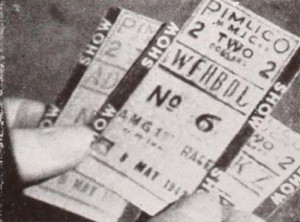
"In Turf Tales, Leonard Bauer, jr., has tackled an acceptedly difficult subject for the personal movie maker — and has done well by it. The subject, as might be guessed, is professional horse racing. The setting of Mr. Bauer's study is the relatively ancient track of Pimlico, outside Baltimore, with the climax of the picture provided by a record of its traditional classic, the Preakness. But the strength of Turf Tales derives more from its highly competent sequences of human interest behind the scenes — the early morning time trials, the stable boys and their chores, the track farrier as he shapes the delicate racing shoes and the strange, unexplained mascots of the high strung thoroughbreds. A commendably restrained narrative, set against a musical background, accompanies the film on a sixteen inch disc recorded by Mr. Bauer." Movie Makers, Dec. 1944, 496-497.
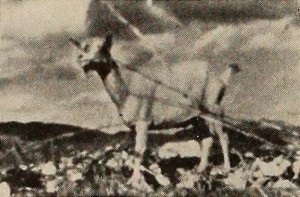
"Vida Pacoima, a two reel study of Mexican life in the southern California village of Pacoima, by Randolph B. Clardy, represents a near miracle in portraying a mood in motion pictures. Whether one likes (i.e., is entertained by) the film or not, there is no gainsaying the amazing emotional effect of its intelligent and beautiful cinematography. Here, in easy going and seemingly unstudied sequence, is the utter aimlessness of the slatternly village and its defeated people. Chickens and children, billy goats and black gowned old women, these are the life of Pacoima. Mr. Clardy has caught them all—either dreaming or drowsy in the sunshine—and presents them with a telling reiteration against the background of their broken homes and through the slats of their sagging fences. A sensuous delight, the photography is as nearly perfect as circumstances would permit, outstripped only by an unerring and often ineffable sense of motion picture continuity. In Vida Pacoima, Mr. Clardy is an artist to his finger tips and a movie maker down to the ground." Movie Makers, Dec. 1938, 617.
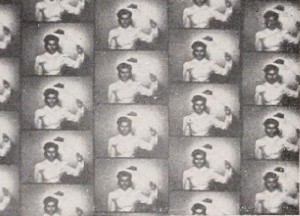
"It is a strange and savage world indeed which Dr. Richard Cassell explores in his Warriors of Another World, a striking recording of nature's continuing and inexorable conflict. His warriors, among others, are the ant lion (with its simple but treacherous sand trap), the scorpion, the mantis, the black widow and the field spider. Into the life of each of these — and their unwary and often unarmed victims — Dr. Cassell has probed with his long focus lenses, to bring back reports of murder, sudden death and cannibalism among the insects. His technical handling of the specialized tools of his trade is beyond reproach, while his continuity treatments range the full gamut of motion picture story telling. Both micro and macrocinematography are used in the film's course, to develop well rounded sequences that are, incredibly, complete with medium shots, near shots, closeups and even reaction scenes made during the tiny but titanic battles. We see (in full frame closeup) the multiple lensed eye of a housefly, only to learn from immediate and striking imagery what such an eye might record — a housewife approaching with a fly swatter. Warriors of Another World is a distinguished contribution to educational film making." Movie Makers, Dec. 1943, 474.
"'West Texas Panther Hunt,' by Tom D. Park of Tulsa, Okla., caused the averting of more than one pair of feminine eyes as the dogs closed in on the big cat, which cuffed them back and might have won freedom except for the man behind the gun behind the dogs" American Cinematographer, April, 1938, 173.
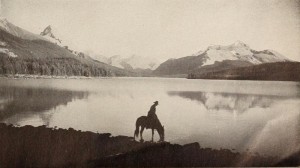
"Western Holiday offered one of those thrills in the sequence of sunrise on Mount Robson. Here Kodachrome caught, with what seemed magic, the first rosy glow on the cold, blue snow, which the continuity of photographic motion permitted to increase, to blossom and, finally, to blaze into a chromatic crown of jewels. To see this on the screen is to enjoy a rare experience. Hamilton H. Jones, in the highly intelligent cutting of his train sequences, gave the student of continuity another of these thrills. Those who are charmed by double turntable accompaniment will recognize the perfection with which an almost impossibly difficult feat of lip synchronization with record scoring has been handled. These are some of the higher spots in a film of unusually high general average. Mr. Jones is a Kodachrome movie maker of proved ability, who has made editing a special art. The film chosen for the first Hiram Percy Maxim Memorial Award will be used by Mr. Jones in his work as a lecturer on the vacation advantages of the Dominion of Canada, although it was made as his own enterprise, entirely at his own expense and not for compensation from a client. It is a part of his professional equipment. Briefly reviewed, Western Holiday carries the audience, via Canadian National Railways, from Victoria, Canada's most westerly metropolis, across the Rocky Mountains back to the Eastern Seaboard. Beginning with city views in Victoria and Vancouver, with strikingly colorful parades of the famous Canadian Mounted Police, we visit tourist centers and make trail trips from them. The camera goes into the interior of a glacier, it finds mountain goats and sheep, it clambers over the Continental Divide on horseback. All through the trip, it studies the progress of trains, weaving in and out of tunnels and over bridges. In his personal presentations of this film, Mr. Jones manipulates effects, such as whistles, bells, train noises and other oddments, with something approaching wizardry. In the face of competition of the highest order, Western Holiday is its own justification of preferment." Movie Makers, Dec. 1937, 602.
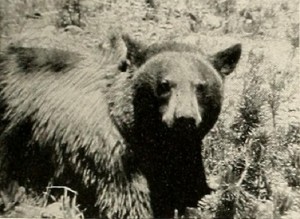
"In making Western Wild Life, Frank E. Gunnell has infused considerable imagination into a film of an essentially factual nature. Broken down into its component parts, this movie is purely didactic — each bird and animal sequence is receded by an identifying title. As a teacher, Mr. Gunnell knows that this type of film is ideally suited for educational use. Technically, it would be difficult to improve Western Wild Life; accurate exposure and focus added to good composition make an excellent film. The closeups of wild birds are some of the finest yet filmed. However, Mr. Gunnell has achieved more than technical excellence, for the film is attractive to naturalist and layman alike. An outstanding characteristic of the film is its highly selective editing. No sequence is too short or too long. Amazing shots of the very rare trumpeter swans provide a fitting climax for a nature film of first rank." Movie Makers, Dec. 1941, 567.
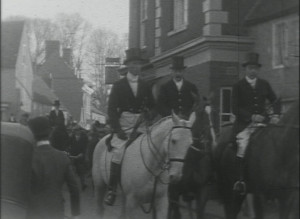
"The Meet of the Whaddon Chase fox hunt on Boxing Day in 1930, with riders on horseback and foxhounds gathering first in Winslow’s market place, attracting a crowd of locals, before heading off to the countryside on this rather grey and foggy day." (EAFA Database)
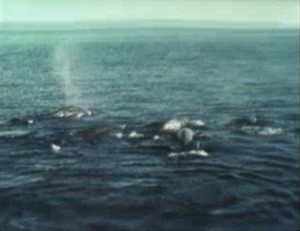
"In January 1986, Dr. Robbins Barstow of Wethersfield, Connecticut, filmed a two-week cruise circumnavigating Mexico's Baja Peninsula. The trip included close encounters with seven different species of cetaceans -- Gray, Humpback, Bryde's, and Blue Whales, three kinds of dolphins, and giant elephant seals." Archive.org
"When The Red Gods Call, 1600 ft., 16mm., is noteworthy as an exceptional record of wild animal life in the great north woods and was made by W. H. Dodge. With infinite patience and camera skill, Mr. Dodge succeeded in recording the natural movements of moose, bear and other wild animal subjects and his photography under difficult conditions, as exemplified in this film, is exceptional. The results gained in many of the telephoto shots and in shots taken with fast lenses and superspeed film were made possible by a specialized cine outfit, developed by the maker of the film himself. Beautiful nature shots, as well as exceptional night and flare work, add to the original qualities of this film." Movie Makers, Dec. 1931, 685-686.
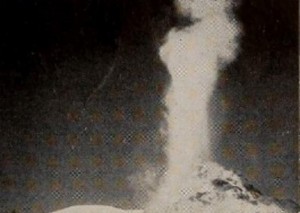
"With While the Earth Remaineth, Hiram Percy Maxim Memorial Award winner for 1945, Frank E. Gunnell crowns a long and distinguished career in the history of personal motion pictures. Beginning ten years ago with Adirondack Adventure, a Ten Best winner on 400 feet of black and white film, this career now embraces no less than ten award winners in nearly every category of amateur movies. Mr. Gunnell's chef d'oeuvre is a stirring and splendid climax to these efforts. The film is based upon the twenty second verse of the eighth chapter of Genesis, wherein the Lord pledges that He shall never again smite the earth, as He had done in the recent Deluge: For while the earth remaineth, seedtime and harvest, and cold and heal, and summer and ivinter, and day and night. shall not cease. Beginning with this great and noble theme, Mr. Gunnell doubles back in his production to show the creation of this Earth which the Lord has blessed. Here, used interpretively rather than for itself alone, Mr. Gunnell's superb craftsmanship with the camera rises to new heights of power and dignity. His sequences suggesting the formation of the cosmos and the first coming of light to the new planet are among the most stirring and purely creative passages in the history of amateur movies. His use of already existing scenes — a geyser or boiling springs of mud — to suggest the primordial genesis are imaginative editing at its highest plane. Flowers, fruits and the fowls of the air take on new beauty in Mr. Gunnell's moving testament to God's handiwork. As befits such a splendid theme, While the Earth Remaineth is scored with music of great stature. Presented with the picture are passages from Beethoven's Pastoral Symphony; the Symphony in D Minor, by Cesar Franck; Robert Schumann's Third Symphony; Harold in Italy, by Berlioz; the Deems Taylor suite, Through the Looking Glass; Omphale's Spinning Wheel, by Saint-Saens. and the Symphony in D Major, by Haydn." Movie Makers, Dec. 1945, 477, 494.
Total Pages: 19